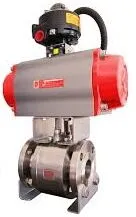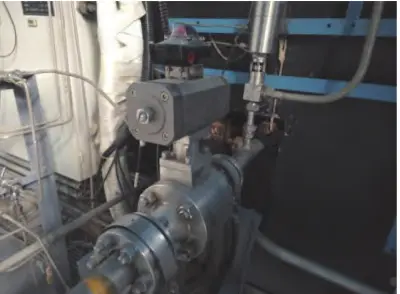State Monitoring and Fault Diagnosis of Electric Valves
Jan 16, 2025
The primary goal of electric valve condition monitoring is to assess whether the equipment is operating correctly and within specified parameters. However, the diagnostic capabilities of the monitoring system are limited, as it can only confirm whether the equipment is operating within expected parameters and provide critical data for further fault diagnosis. Fault diagnosis for electric valves focuses on identifying latent faults during operation, evaluating current performance, monitoring the degradation of components, and forecasting potential failures. In most instances, fault diagnosis does not require the continuous operation of the equipment and is typically carried out offline.
Electric valves are operated by electric actuators, which control the valve's opening and closing. These valves primarily consist of drive motors, transmission components, and valve bodies. Due to their compact size, low manufacturing complexity, and cost-effectiveness, electric gate valves are widely used in large-diameter pipelines, especially in nuclear power plants. This paper uses the typical electric gate valve as a case study to examine its fault characteristics and detection methods.
As shown in Figure 1, a typical electric gate valve is powered by a drive motor that generates rotational force. This rotational movement is converted into linear up-and-down motion of the valve stem via the valve stem nut inside the valve body. The electric gate valve uses a gate plate or disc to block or allow fluid flow. The valve stem moves the gate plate vertically, thereby controlling the opening and closing of the fluid passage.
The valve stem thrust curve during the closing stroke of the electric gate valve is shown in Figure 2. When the valve receives a closing signal, the motor is activated, driving the worm gear to rotate. This rotation gradually reduces the force applied to the valve stem until the hammer effect occurs. At this point, the valve stem nut begins to rotate, releasing the tension on the valve stem. Once the valve stem passes through the threaded gap, the force is reduced to zero. The valve stem nut then begins to push the valve stem downward. As the valve stem moves, it passes through the T-slot of the valve disc and the packing, ultimately seating the valve disc against the valve seat.
The valve stem thrust curve during the opening stroke of the electric gate valve is shown in Figure 3. Upon receiving an opening signal, the motor is activated, causing the worm gear to rotate. This reduces its torque on the worm wheel, drive sleeve, and valve stem nut. The friction between the valve stem and the valve stem nut, resulting from the self-locking feature of the valve stem, causes most of the force on the valve stem to remain. When the worm gear engages the hammer ear of the drive sleeve, the drive sleeve rotates, further driving the valve stem nut. This process continues until the compression force on the valve stem is fully released. At this point, the valve stem begins to move upward, and the valve disc finally lifts off the valve seat.
Electric valves may experience various types of failures during operation, which can occur in sequence or simultaneously. Based on their failure modes, the primary failure categories are classified into 13 types:
- Aging, deterioration, or insufficient lubricating oil
- Torque switch failure
- Reduced closing torque switch setpoint
- Increased closing torque switch setpoint
- Reduced opening torque switch setpoint
- Increased opening torque switch setpoint
- Decreased open limit switch activation value
- Increased open limit switch activation value
- Decreased close limit switch activation value
- Increased close limit switch activation value
- Contaminated valve stems
- Excessive packing gland screw torque
- Insufficient packing gland screw torque
Aging or insufficient lubricating oil can impair the lubrication of the mechanical transmission system, leading to increased wear and potentially causing slippage or failure of the transmission mechanism. This may result in delayed valve action or failure to operate.
Failure characteristic parameters
- Increased three-phase current and active power consumption
- Extended switching time
- Increased valve stem thrust
If the torque switch is damaged and the contacts remain closed, the valve will not stop when the electric actuator is engaged. This can lead to motor burnout, damage to the valve stem or stem connector, and may compromise the valve body’s sealing surface. If the contacts are open, the electric actuator will not operate.
Fault characteristic parameters:
- Excessive current, power, and thrust during valve operation (either opening or closing)
- Failure of the torque switch to engage or reset
When friction is high during the valve closing process, the closing torque switch may prevent proper seating of the valve, leading to internal leakage.
Fault characteristic parameters:
• Reduced current and power when the closing torque switch is actuated;
• Decreased seating force;
• Shortened valve closing time.
Excessive seating force can damage the sealing surface, leading to internal leakage, and may also cause damage to the valve stem and electric actuator.
Fault characteristic parameters:
- Increased current and power upon actuation of the closing torque switch
- Increased seating force
- Prolonged valve closing time
If the opening torque switch is activated prematurely during the valve opening process, the valve will not open.
Fault characteristic parameters:
• Reduced current and power during opening torque switch activation
• Reduced tension on the valve stem
• Shortened valve opening time
Excessive opening torque may damage the valve stem, sealing surface, and electric actuator.
Fault characteristic parameters:
• Increased current and power during opening torque switch activation
• Increased tension on the valve stem
• Prolonged valve opening time
When the opening stroke control malfunctions, the valve may fail to open fully, resulting in throttling.
Fault characteristic parameters:
• Reduced valve stroke
• Shortened switching time
When the open limit switch fails, the valve will be controlled solely by torque protection, which could prevent proper valve opening.
Fault characteristic parameters:
• Increased valve stroke
• Prolonged switching time
When the closing stroke control malfunctions, the valve cannot fully close, causing internal leakage.
Fault characteristic parameters:
• Reduced valve stroke
• Shortened switching time
When the closing limit switch fails, the valve will be controlled solely by the closing torque switch, which may lead to valve damage.
Fault characteristic parameters:
• Increased valve stroke
• Prolonged switching time
Contaminated valve stems can cause the valve to function improperly, increase friction, and accelerate wear.
Fault characteristic parameters:
• Increased three-phase current and power
• Increased friction
As the system temperature increases, the packing may expand, potentially causing the valve stem to seize and malfunction.
Fault characteristic parameters:
• Increased three-phase current and power
• Increased friction
As the system temperature decreases, the packing contracts, which can cause valve stem leakage.
Fault characteristic parameters:
• Decreased three-phase current and power
• Decreased friction
Analyzing the fault modes and characteristics of the electric valve provides valuable data to support fault diagnosis, enabling quick identification of issues and timely corrective measures.
Previous: Mitigating Hydrogen Corrosion in High-Pressure Hydrogenation Gate Valves
Next: Application of Ceramic Valves in Calcium Carbide Slurry Production


